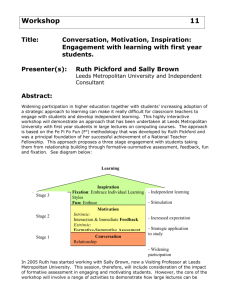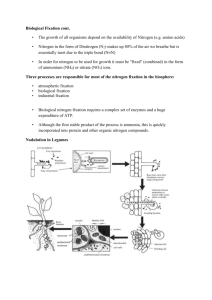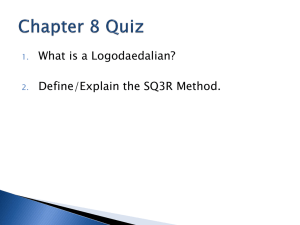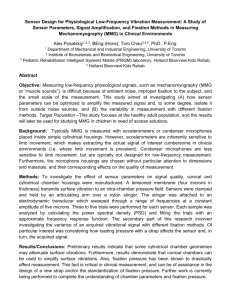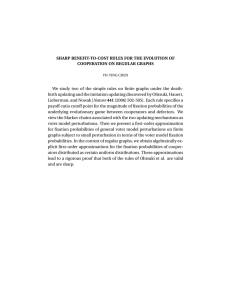IHC fixation protocol Procedure for cell culture and tissue samples
advertisement
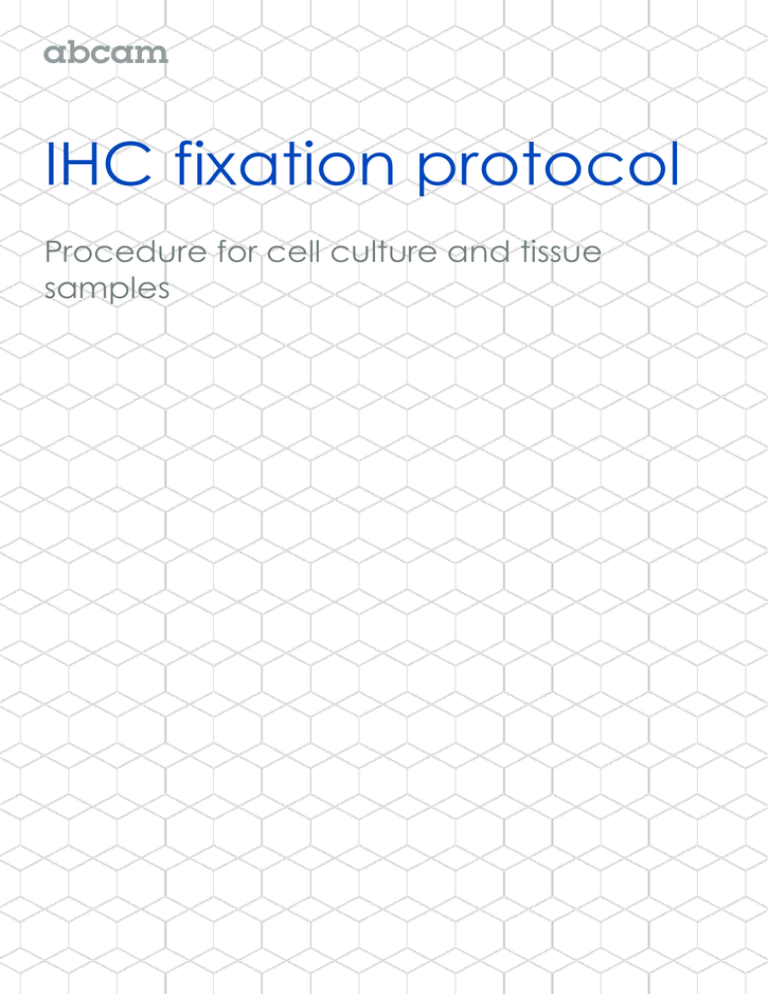
IHC fixation protocol Procedure for cell culture and tissue samples IHC fixation protocol Contents – – – Introduction Fixation methods for cell culture samples Fixation methods for tissue samples – Immersion fixation – Perfusion fixation – Frozen sections fixation Introduction Fixation immobilizes antigens while retaining cellular and subcellular structure. The fixation method used will depend on the sensitivity of the epitope and the antibodies themselves and may require some optimization. Fixation can be done using crosslinking reagents such as paraformaldehyde. These are better at preserving cell structure, but may reduce the antigenicity of some cell components as the crosslinking can obstruct antibody binding. Antigen retrieval techniques may be required, particularly if there is a long fixation incubation time or if a high percentage of crosslinking fixative is used. Fixation methods for cell culture samples Formalin – Add 10% neutral buffered formalin (NPF) to slides for 10 min. – Wash 3x with PBS. Fixing in formalin for more than 10–15 min will cross-link the proteins to the point where antigen retrieval may be required to ensure the antibody has free access to bind and detect the protein. Ethanol – Add 100–200 μL of 95% ethanol, 5% glacial acetic acid per slide. – Place at -20°C for 5–10 min preferably in Coplins jar. – Wash 3x with PBS. 2 Methanol – Add 100–200 μL of ice cold methanol, 5% acetic acid per slide. – Place at -20°C for 10 min preferably in Coplins jar – Wash 3x with PBS. Ethanol and methanol will also permeabilize. Some epitopes are very sensitive to methanol as it can disrupt epitope structure. If this is occurring, try acetone instead if permeabilization is required. Acetone – Add 100–200 μL ice cold acetone per slide. – Place at -20°C for 5-10 min. – Wash 3x with PBS. Acetone will also permeabilize. No further permeabilization step is required. Fixation method for tissue samples Immersion fixation 10% neutral buffered formalin (NBF) is most commonly used. Where our datasheets state IHC-P as a tested application, this fixative has been used unless stated otherwise. Other fixatives such as Bouin solution (paraformaldehyde/picric acid) are used less frequently. The ideal fixation time will depend on the size of the tissue block and the type of tissue, but fixation between 18–24 h seems to be suitable for most applications. Underfixation can lead to edge staining, with strong signal on the edges of the section and no signal in the middle. Over-fixation can mask the epitope; antigen retrieval can help overcome this masking, but if the tissue has been fixed for a long period of time (ie over a weekend), there may be no signal even after antigen retrieval. Perfusion fixation Adequate fixation is often obtained by immersion of small tissue pieces into the fixative solution. However, a more rapid and uniform fixation is usually obtained if the fixative solution is perfused via the vascular system, either through the heart or through the abdominal aorta. The following procedures provide fixation of most rat organs with 4% paraformaldehyde. 3 Materials for perfusion fixation – – – – – – – – – – – – Anesthetic Scissors, forceps, and clamps for surgical procedures Small forceps with fine claws Scalpel Vials (5–10 mL) with lids for specimens 0.9% saline 500 mL beakers 4% paraformaldehyde, fixation solution Gloves, eye goggles Perfusion pump (or flask with fixative placed upside down about 150 cm above the operating table) Short syringe needle for heart perfusion of aorta, length about 50 mm, outer diameter 1.3–1.5 mm Perfusion set with drip chamber as used for intravenous blood infusions Perfusion fixation through the heart 1. Set up perfusion pump; attach perfusion set and perfusion needle. First, run about 100 mL of tap water through the tubing to remove any residue. Then place the open end of perfusion tube in beaker filled with cold 4% paraformaldehyde (in ice box). The volume of solution should be scaled to the size of the animal and usually 200–300 mL will be sufficient for one animal. Open valve and adjust to a slow steady drip (20 mL/min), and then close valve. 2. Set up surgery site with scissors, forceps and clamps. Give an appropriate amount of anesthetic to the animal. Once the animal is under anesthesia, place it on the operating table with its back down. You may use some tape to hold the appendages so that the animal is securely fixed. 3. Use pinch-response method to determine depth of anesthesia. The animal must be unresponsive before proceeding with the following steps. 4. Make an incision with a scalpel through the abdomen, the length of the diaphragm. With sharp scissors, cut through the connective tissue at the bottom of diaphragm to allow access to rib cage. 5. With large scissors, blunt side down, cut through ribs just left of the rib cage midline. 6. Make one center or two end horizontal cuts through the rib cage, and open up the thoracic cavity. Clamp open to expose the heart and provide drainage for blood and fluids. 7. While holding the heart steady with forceps (it should still be beating), insert needle directly into the protrusion of the left ventricle to extend straight up about 5 mm. Be careful not to extend the needle too far in, as it can pierce an interior wall and compromise circulation of solutions. Secure needle position by clamping in place near the point of entry. Release valve to allow slow, steady flow of around 20 mL/min of 0.9% saline solution. 8. Make a cut in the atrium with sharp scissors, and make sure solution is flowing freely. If fluid is not flowing freely or is coming from the animal’s nostrils or mouth, reposition the needle. 4 9. When blood has been cleared from body, change to 4% paraformaldehyde solution (200–300 mL). Take care not to introduce air bubbles while transferring from one solution to the other. It is best to wear protective eye goggles during the whole perfusion process. 10. Perfusion is almost complete when spontaneous movement and lightened color of the liver are observed. (In general, an adult rat would require around 30–60 min of perfusion time but this may vary depending on the size of the animal and technique.) 11. Stop the perfusion and excise the tissue of interest. Place them in vials containing the same fixation solution and fix for a further 2 h on ice or at 4°C before proceeding to dehydration and embedding. For better results, immersion-fix overnight at 4°C. Perfusion fixation through the abdominal aorta 1. Prepare materials and animal as above (steps 1–3). 2. Open the abdominal cavity by a long midline incision with lateral extension, and move the intestines gently to the left side of the animal. 3. Carefully expose the aorta below the origin of the renal arteries and very gently free the aorta from overlaying adipose and connective tissues. 4. Hold the wall of the aorta firmly with fine forceps with claws about 0.5–1.0 cm from its distal bifurcation. Insert a bent needle close to the forceps towards the heart into the lumen of the aorta. 5. In very rapid succession: – – – Cut a hole in the inferior caval vein with fine scissors Start the perfusion Clamp the aorta below the diaphragm, but above the origin of the renal arteries When performing these manipulations accuracy and speed are essential and the fixation procedure is preferably carried out by two persons. It is particularly important to clamp the aorta rapidly after the perfusion has been started. This is most easily done by compressing the aorta toward the posterior wall of the peritoneal cavity with a finger (wear gloves) which is then replaced by a clamp. Finally, cut the aorta above the compression. 6. The kidney surface must blanch immediately and show a uniform, pale color. The flow rate should be at least 60–100 mL/min for an adult rat. Perfuse for 3 min. Stop the perfusion and excise and trim the tissues. Store the tissue in vials and immersion-fix in the same fixative (post-fixation step) for 2 h on ice or at 4°C. For better results, immersion-fix overnight at 4°C. 7. The tissue is now ready for dehydration and embedding. 5 IHC fixation protocol Perfusion fixation troubleshooting Problem Solution Solution coming out of animal’s orifices – the needle is inserted incorrectly. Try to get the needle up the left atrium so that the solution does not flow into the lungs. Be careful not to insert the needle too far up as there is a risk of puncturing an internal wall. Getting the right position may require some practice, so try moving the needle around a bit until the solution stops flowing from the animal’s nostrils or mouth. Fixation taking too long – the fixative solution is not circulating properly. Make sure that you have properly clamped the needle at the point of entry and that there is no leakage/puncture to the heart. This can be easily done by dabbing dry the area around the heart to see if the fixative is leaking out. Also, try repositioning the needle insert. Punctured heart – the perfusion fixation may not be complete and the sample organ/tissue may not be properly fixed. Try to clamp the puncture wound close. Continue with the perfusion fixation but make sure to fix the organ in the same fixation for more than two hours after excising it. In this case, it would be best to do immersion-fixation at 4°C, overnight. If your sample organ is a testis, after excising it, try injecting some of the fixative into the apical regions, right under the tunica albuginea layer, so that the seminiferous tubules inside will be fixed. The testis will bloat up a bit and feel hard if it is has been injected correctly. If you are able to locate a vein in your sample organ, you can manually try to inject (using a syringe) the fixative solution into the vein. 6 IHC fixation protocol Frozen sections fixation 1. Once mounted on 3-amino-propyl-tri-ethoxy-silane (APES)-coated slides, sections should be air dried under airflow for 30–60 min to ensure complete desiccation as possible. 2. Store sections at -80°C until needed. For best results, use immediately. 3. When required, leave to warm at room temperature for 5 min. 4. Prepare fixative (acetone, methanol or ethanol) at room temperature. For a new antibody, we recommend starting with three sides: – – – Paraformaldehyde Acetone 1:1 solution of acetone:alcohol (methanol or ethanol) 5. Fix with the fixative for 15 min, at room temperature. 6. Rinse 3–4 times in PBS. 7. For acetone fixation, air dry completely for 30 min under airflow. 8. Continue with the immunohistochemical staining protocol. If the tissue samples are fixed with an aldehyde fixative (paraformaldehyde, glutaraldehyde etc) for immunofluorescence detection, include 0.3 M glycine in the blocking buffer, before applying the primary antibody. Glycine will bind free aldehyde groups that would otherwise bind the primary and secondary antibodies, leading to high background. Background due to free aldehyde groups is more likely to occur when the fixative is glutaraldehyde or paraformaldehyde. 7


